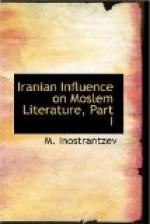Gutschmid already noticed in his time that by the Persian historians to each Sasanian ruler was ascribed a maxim and indicated that with reference to Ardashir and Anoshiravan these maxims may be taken as the basis since the Book of Counsels of the former was well-known and a large number of edifying proverbs of the latter had found admittance into the national language.[1] Let us add that, as we showed above, there has been preserved a similar class of Books of Counsels, the reputed author of which is Anoshiravan. The putative dicta of the other Sasanian kings Gutschmid considered as fabricated being designed to be brief characterisations of each of them. Gutschmid further advanced the conjecture that these apophthegms formed the texts under the portraits of the kings in the book which was used by Hamza Ispahani[2] and which was seen by Masudi.[3] According to the information supplied us by the latter (Masudi) he saw this book in Istakhr in an aristocratic Persian family, and that it included, besides information of a scientific character, the history of the Persian kings and their reigns and a description of the monuments erected by them.[4] In the book were the portraits of the Sasanians and it was based on the documents found in the royal archives. And the portraits also were prepared from the materials deposited there. The book was completed in A.H. 113 (A.D. 731), and it was translated for the Khalif Hisham from the Persian into the Arabic language.
[Footnote 1: Gutschmid, Kleine schriften, III, 35-36.]
[Footnote 2: About this book see Gutschmid, III, 150-151.]
[Footnote 3: B.G.A. VIII, 106, 5-107, 5. Translation by Carra de Vaux 150-151. See Christensen 90-91.]
[Footnote 4: Gutschmid 150, 151.]
We called attention above to the information supplied by Istakhri and Ibn Haukal regarding the castle of Shiz and the preservation in it of the archives and the portraits of the Sasanian kings. It is highly probable that for the reproduction of these portraits of the sovereigns the authors were guided as much by the bas-reliefs, not far from this castle, as by the tradition regarding them which was embalmed in older books belonging to the class mentioned by Masudi which undoubtedly existed in the Imperial archives.[1] Along with the literary tradition there must have survived the artistic tradition. It is highly probable that the peculiar Persian art of illuminating manuscripts which was yet unknown according to Masudi in his own time,—the embellishing of books with gold, silver, and copper dust was practised by the Manichians whose calligraphy[2] delighted the Musalman authors and whose style of illustrating manuscripts must have been fashioned after the art displayed in those books which in the tenth century were preserved in the castle of Shiz[3] and which at an earlier period were widely desseminated among the Parsi circles.
[Footnote 1: Connected with ancient tradition, but dependant upon modern science, are the portraits of the Sasanian kings in the recently published Nameh Khusrawan, Tehran 1285, (A.D. 1868).]




